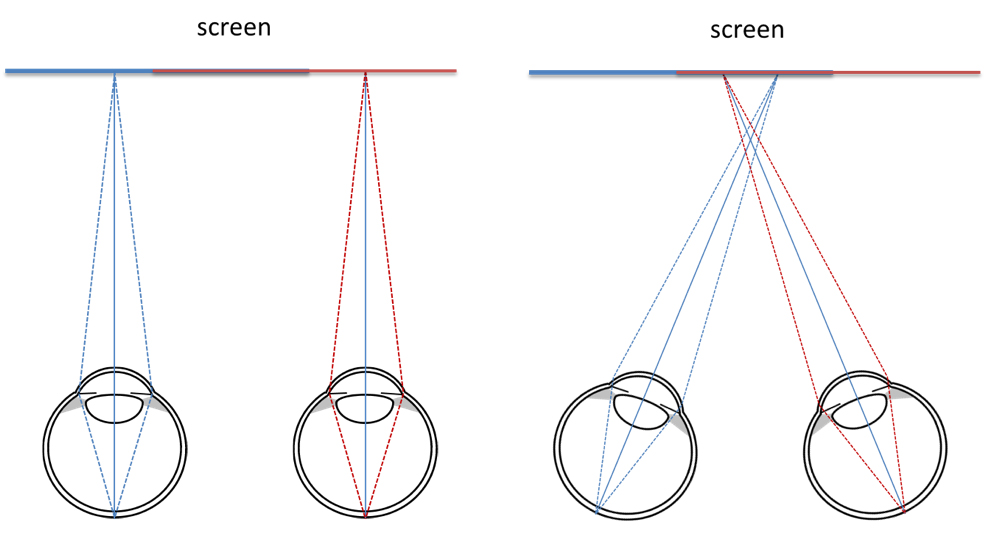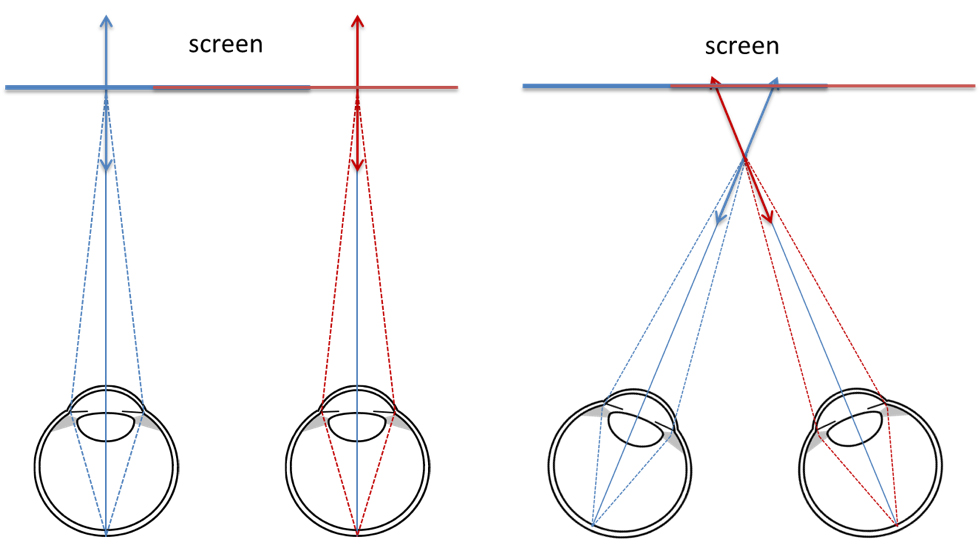
Advanced Physiological Optics Laboratory
Yoon Lab

Since its invention by Sir Charles Wheatstone in 1838 [1], the stereoscope has served as a productive tool for physiological experiments as well as amusement. The first stereoscope used a pair of mirrors in front of the eye. Two drawn images were reflected by the mirrors and observed. The disparity between the two images gave the subject a sense of stereopsis. Later, David Brewster suggested the use of lenses in a stereoscope. The schematics he proposed were similar to modern head-mounted displays (HMD)[2].
A virtual reality (VR) system provides an experience to the user of feeling immersed in a virtual world. In 1965 the invention of ‘Sketchpad’ system marked the beginning of VR[3]. Later, interactions through body movement were also integrated in the VR system. It was NASA that first developed the first complete VR system. It prototyped Liquid Crystal Display (LCD) panels in a HMD[4]. Nowadays, VR devices are being manufactured and commercialized by leading companies like HTC and Oculus. People can now enjoy 3-dimensional (3D) perception through a combination of visual perception, hearing and motion tracking.
However, the VR systems available on the market suffer from visual discomfort that degrades the user experience. Visual discomfort can result from excessive binocular disparity, the mismatch between accommodation and convergence, distortions from a stereoscope, artificial depth of focus (DoF) and 3D artefacts[5]. We are interested in the mismatch between accommodation and convergence, which is also called the vergence-accommodation (VA) conflict. In the real world, convergence and accommodation are neurally coupled, however, in a head-mounted stereoscope, the screen is at a fixed position. If the subject wants to see a clear image, the accommodation should stay the same. However, when disparity is displayed, the subject’s convergence changes, thus accommodation and convergence do not match. This decoupling of accommodation and convergence is VA conflict. This conflict is argued to cause visual fatigue [6]. Techniques such as multi-plane imaging, holography, liquid lens and monovision have been investigated to discover potential solutions for the VA conflict.
Fincham et al. addressed the reciprocal actions of accommodation and convergence[7]: Accommodation can induce convergence with monocular stimulus, and convergence can also induce accommodation under open-loop condition (with infinite depth of focus). Furthermore, spherical aberration (SA) is known to increase the DoF of the eye, a property which could conceivably be used to alleviate VA conflict.

Figure 1. No VA conflict on the left, but VA conflict happens on the right. The eyes keep accommodation for sharp focus on the screens, but they converge at the same time.

FFigure 2. Due to extended DoF, the eyes on the right can both converge and accommodate at the same time, as long as the screens are still within DoF.
We choose SA to extend DoF. By combining SA4 and SA6 or even higher order SAs, we can extend the DoF with balanced thorough-focus visual performance. The SA designs for the two eyes can be different from each other. The subjects are tested by the binocular adaptive optics vision simulator, which can change its convergence for the two eyes.
References:
1. Wheatstone, C., Contributions to the Physiology of Vision.—Part the First. On some remarkable, and hitherto unobserved, Phenomena of Binocular Vision. Phil Trans R Soc, 1838. 128: p. 371-394.
2. Brewster, D.S., The Stereoscope; its History, Theory, and Construction, with its Application to the fine and useful Arts and to Education: With fifty wood Engravings. 1856: John Murray.
3. Sutherland, I.E., Sketchpad: A Man-Machine Graphical Communication System, in DAC '64 Proceedings of the SHARE design automation workshop. 1963. p. 329-346.
4. Paolis, L.T.D. Virtual Reality TechnologyVirtual and Augmented Reality Applications. 2003; Available from: http://avrlab.it/wp-content/uploads/2015/03/lez-1-introduction.pdf.
5. Marc T.M. Lambooij, W.A.I., Ingrid Heynderickx, Visual Discomfort in Stereoscopic Displays: A Review. Stereoscopic Displays and Virtual Reality Systems XIV, 2007. 6490.
6. S. Yano, M.E., and T. Mitsuhashi, Two factors in viusal fatigue caused by stereoscopic HDTV images. Displays, 2004. 25: p. 141-150.
7. Fincham, E.F.W., J., The reciprocal actions of accommodation and convergence. J. Physiol., 1957. 137: p. 488-508.